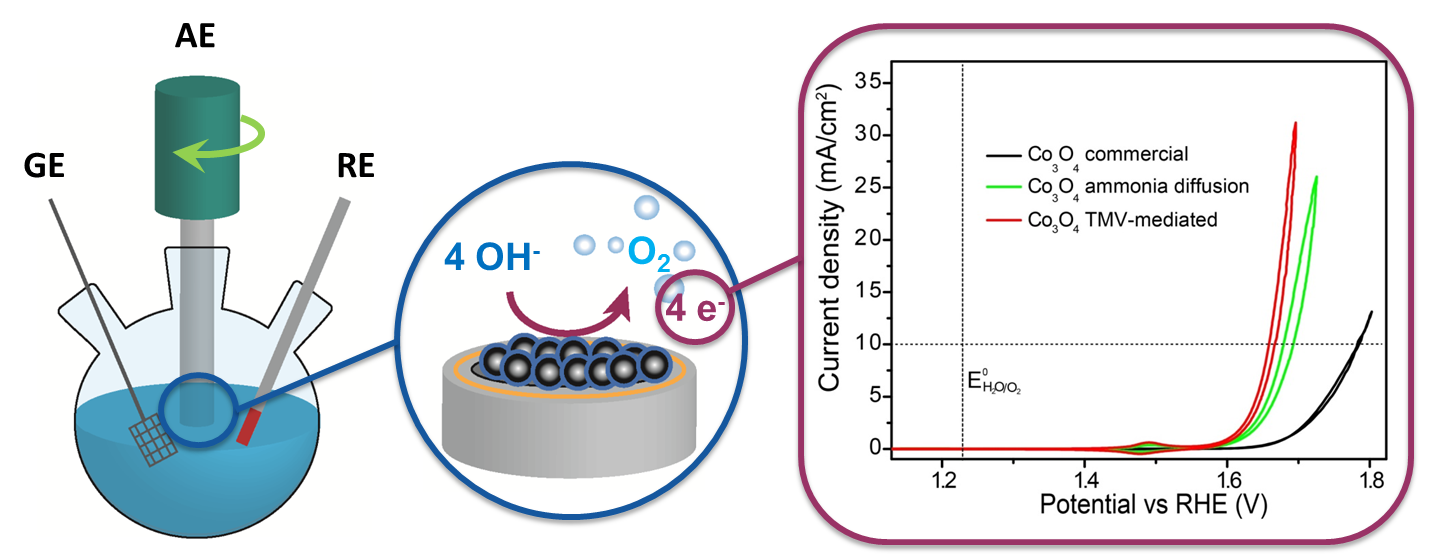Structure-property relationships in mesostructured transition metal oxides
Spinel-type Co3O4 finds applications in a wide range of technological fields, including gas sensing and clean energy conversion, where nanostructured Co3O4 may provide a cost-efficient alternative to Pt- and Ir-based catalysts for electrocatalytic water-splitting.

Figure 1: Immobilization of catalyst particles on a rotating disc electrode. A suspension of the mesostructured material in Nafion solution is drop-casted onto the electrode surface followed by solvent evaporation.
The performance of Co3O4 as an electrocatalyst has previously been shown to depend on structural parameters including the surface area, size and morphology of the particles. To compare oxide mesostructures prepared according to different protocols with respect to their catalytic activity, we measure the overpotential towards the oxygen evolution reaction (OER). For this purpose, the materials are immobilized on a rotating disc electrode (Figure 1).
We have recently demonstrated that Co3O4 obtained by calcination of ammonia diffusion-grown precursors in both, the absence or presence of structure-directing tobacco mosaic virus particles (TMV) shows a significantly lower overpotential towards the OER than a commercial nanopowder that consists of particles with irregular shapes (Figure 2).

Figure 2: Examination of mesostructured metal oxide particles as electrocatalysts for water splitting. Left: Schematic illustration of a three-electrode electrochemical cell equipped with a rotating disc electrode (RDE) as working electrode (WE), a glassy carbon rod as counter electrode (CE), and a double junction Ag/AgCl reference electrode (RE). Centre: Catalyst particles (black) immobilized on the surface of the RDE. Right: Cyclic voltammograms recorded for a commercial cobalt oxide powder (black line), for cobalt oxide particles obtained by calcination of an ammonia diffusion-grown precursor (green line), and for virus-directed cobalt oxide (red line).
Our future research in this area will expand on studying the electroctalytic performance of a wider range of structures and materials and we are currently exploring a variety of synthetic approaches for the preparation of primary transition metal oxide nanoparticles.
Our work on metal oxide nanoparticle synthesis and assembly is supported by SFB 840.
- Anna S. Schenk, Sabine Eiben, Miriam Goll, Lukas Reith, Alex N. Kulak, Fiona C. Meldrum, Holger Jeske, Christina Wege, Sabine Ludwigs, Virus-directed formation of electrocatalytically active nanoparticle-based Co3O4 tubes, Nanoscale 2017, 9, 6334 - 6345.
- Anna S. Schenk, Miriam Goll, Lukas Reith, Manuel Roussel, Björn Blaschkowski, Sabine Rosenfeldt, Xiaofei Yin, Wolfgang W. Schmahl, Sabine Ludwigs, Hierarchically Structured Spherulitic Cobalt Hydroxide Carbonate as a Precursor to Ordered Nanostructures of Electrocatalytically Active Co3O4, Crystal Growth & Design 2020, 20 (10), 6407-6420.
